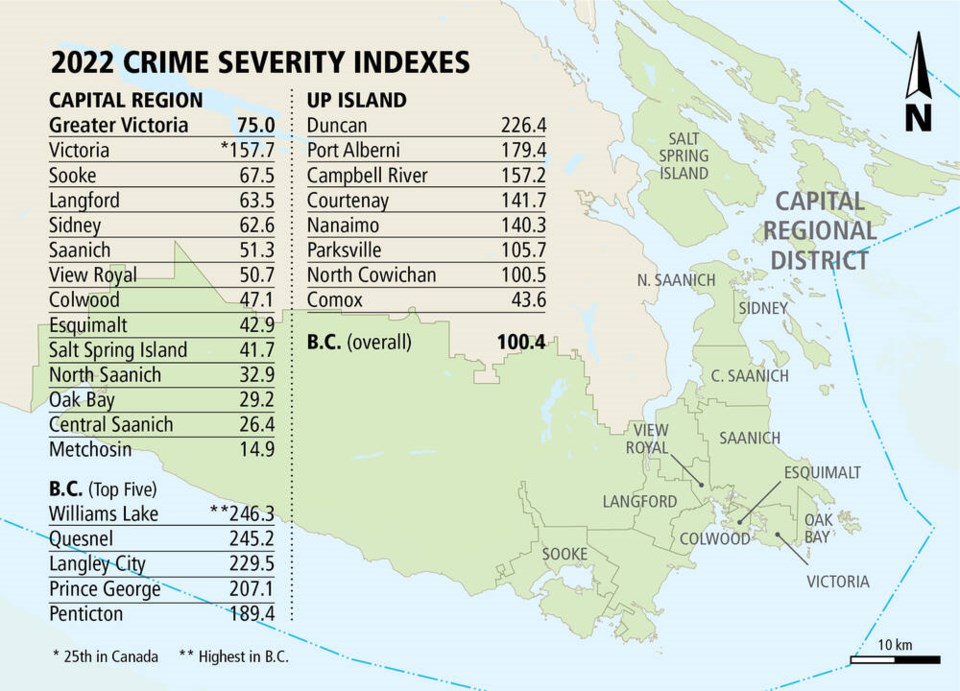Victoria’s crime severity index is once again nearly 60 points higher than the provincial average, which some are calling a sign that it’s time to establish a regional police force for the south Island.
Statistics Canada data released this month show the volume and severity of police-reported crime in Victoria last year was also well above that of Vancouver.
The index, which measures the volume and severity of police-reported crime, showed that last year, Victoria’s index increased to 157 from 148 in 2021, well above the provincial index of 100 and Vancouver’s 92. When all 13 municipalities in Greater Victoria are combined, the severity index is 75.
The index is meant to be a more meaningful interpretation of broad statistics as it weighs the severity of crimes reported, rather than the more simplistic crime rate, which can be affected by the number of petty thefts reported.
The fact that Victoria’s number, the highest for any municipally policed jurisdiction in the province, is high should come as no surprise, said Simon Fraser University criminology professor Rob Gordon.
Gordon noted that Victoria is the region’s playground and the centre of the south Island, where a large number of people live, work and play.
“Trying to understand what’s going on in Victoria is not complicated. It’s the hub, and because it’s the hub, people pass through, stay there, live there, move on to other places,” he said. “It’s a collection of locations where crime is more likely to occur just by virtue of people going through.”
VicPD spokesman Bowen Osoko said the high index is frustrating. “It’s not just that there’s been no significant change — it’s that we’ve been above the provincial average the entire time we’ve been doing this measure where we’ve been separating out Victoria and Esquimalt,” he said.
“When you’re 50 to 60 points above, it really speaks to the challenges that we face — right now our officers are dealing with lots of crime and lots of severe crime.”
Osoko pointed out the bulk of the region’s clubs and bars are downtown, the city hosts most of the major events, and it has the greatest concentration of services used by high-need and vulnerable populations.
VicPD Chief Del Manak, who has argued for years that his department is shouldering more than its share of the burden in the region, has long advocated for a regional force that would allow police to scale the number of officers on duty up or down and apportion response where it’s most needed.
Gordon said people shouldn’t be too worried about the index number, but they should be concerned about the lack of co-ordination between police services in the region.
He said he holds out some hope that change is coming.
Gordon said last year’s provincial report on reforming the Police Act clearly called for a regional police service for places like Victoria.
The special committee’s report made 11 recommendations that call for transformational change in policing and community safety. One of the recommendations was to amalgamate police services on a regional basis where there are opportunities to address fragmentation, ensure equitable access to policing and public safety, and improve efficiency and effectiveness.
“It’s clear that the people involved felt that there should be regional police services in the province and that Victoria was one of the locations that was highlighted,” said Gordon, adding there finally seems to be some political will to make it happen, as the province has set aside funding to implement the recommendations of the report.
Osoko said VicPD supports regionalization because it will mean more efficiency, better service and some relief for the force’s officers. “Right now, our officers are often carrying some of the highest caseloads in the province,” he said.
Osoko noted when the Esquimalt and Victoria forces were brought together in a shared-services agreement in 2002, Esquimalt was told it was the first step toward regionalization.
“Things have clearly stalled,” he said. “And it’s pretty clear that we’re still seeing the impacts of that. So we’re kind of hoping our partners [in government] see what’s happening and take the steps necessary.”
The index also shows that many small towns have very high index ratings.
On the Island last year, Duncan’s index was 226, Port Alberni’s was 179 and Campbell River’s was 157.
But the numbers can be misleading because it takes fewer incidents in a smaller town to meaningfully shift the value of the index.
According to Statistics Canada, a double homicide in a small town would likely cause a large increase in the rate of homicide for that town where there typically are no homicides in a given year.



